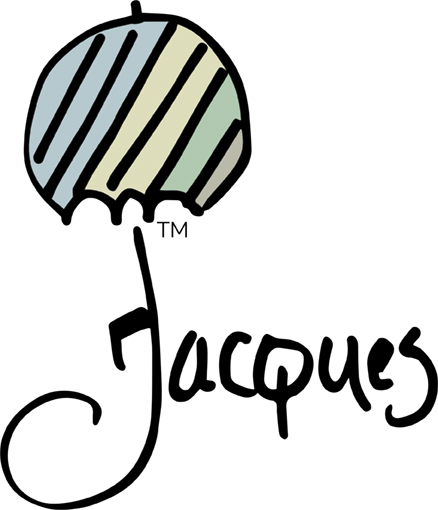In this lengthy interview, Jacques talks about his artistic inspiration, his “Art of the Chicken” book, tips for buying chicken and eggs, cooking liver, mishaps with chicken embryos and Julia Child, a cooking demonstration catastrophe, why you should cook with your kids early, different kinds of omelets, a new style of culinary education, stories from the French president, Charles DeGaulle’s kitchen and “James Beard and the Joys of Free Wine.”
“Jacques Pépin is a man who needs no introduction, but we’ll give it a shot. After cooking for multiple heads of state in France as a young chef, he immigrated to America and started working at the now-legendary French restaurant Le Pavillon. That’s already an illustrious cooking career, but the thing that has made Pépin a culinary icon is his commitment to education. He’s authored over two dozen cookbooks, including the classic “La Technique” (via Art Net), and hosted a wide variety of cooking shows since the 1980s (via IMDb).
Below are some excerpts from the interview:
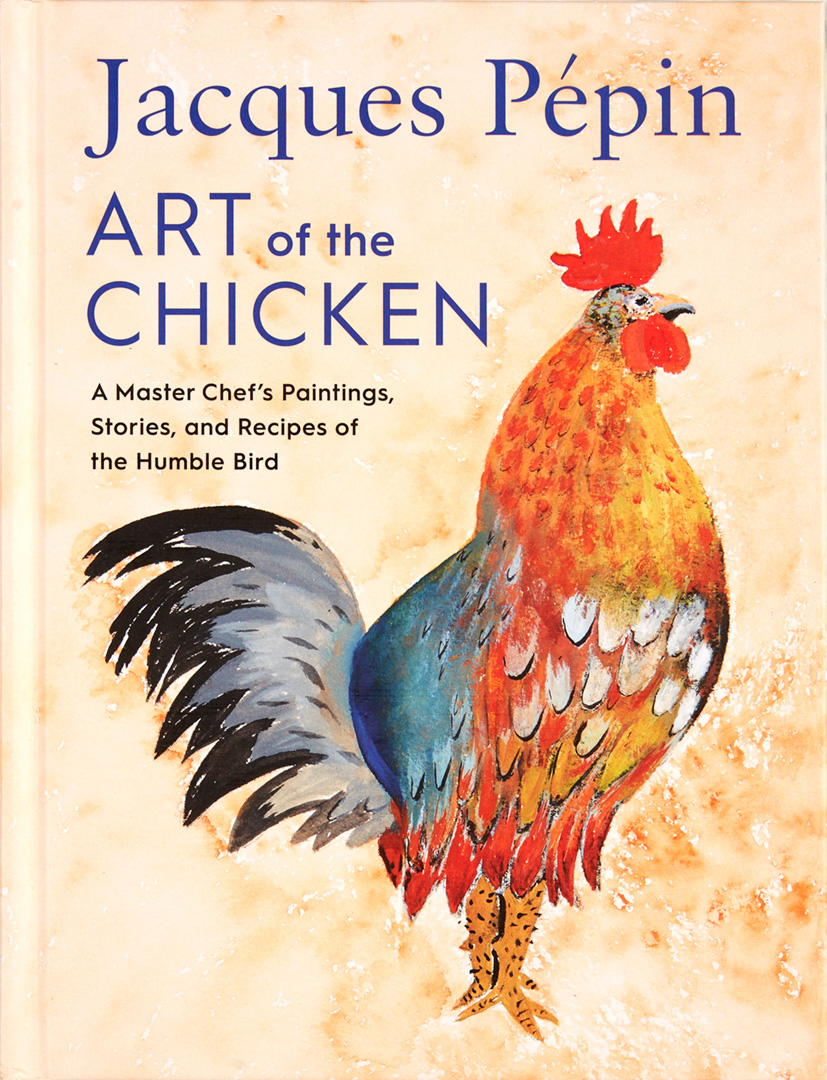 Jacques’ “Art of the Chicken” Book [*]
Jacques’ “Art of the Chicken” Book [*]
“Jacques Pépin’s new cookbook, “Art of the Chicken,” is a little bit of a change of pace from his previous work. It has recipes, but it’s also a memoir. Perhaps most importantly, it’s a gallery of dozens of drawings and paintings of chickens that the chef has created over the years. Yes, in addition to his culinary mastery, Pépin is also quite proficient with a paintbrush. In an exclusive interview with Tasting Table, the chef talked about his love of chickens, his food philosophy, and his run-ins with other famous food personalities.”
*Quotation above is taken directly from the website cited and is the property of that source. It is meant to inform the reader and to give credit where it is due.
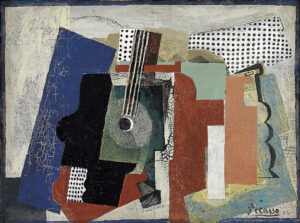 Jacques Artistic Inspiration [*]
Jacques Artistic Inspiration [*]
“What artists inspired you to take up painting?
I have been painting since the late ’50s or early ’60s. I’ve been painting forever, in my free time. I was married for 54 years. From the beginning, when we were married, we had a little house in the country. When people came for dinner, then we would write down the menu, whatever we ate, and people would sign on the other page and say funny things. We would put the label of the wine on it, [and] we would write even the music we played.
I illustrated the menus, and I realized I illustrated with chickens very often. I have 12 or 13 books of those menus, which is basically my whole life. My daughter came a few weeks ago, and she’s now in her mid-50s. She said, “What did I eat for my third birthday?” I said, “Let’s look,” and we looked, and we found her, with all these chicken drawings. That was probably the beginning of what I do now.
If you could cook for one artist you love, who would you pick?
That’s a good question … probably Picasso. Yes, because of the diversity of what he did, from the blue period to abstract art.”
*Quotation above is taken directly from the website cited and is the property of that source. It is meant to inform the reader and to give credit where it is due.
 Mishaps with Chicken Embryos and Julia Child [*]
Mishaps with Chicken Embryos and Julia Child [*]
“One theme in the book is that, over your life, you’ve tried all of these chicken dishes that were new to you. The only egg dish you weren’t able to eat was a raw chicken embryo in China. What did you do when you were face-to-face with the embryo and realized you weren’t going to be able to eat it?
All the people in front of me were Chinese. They were breaking the egg, getting the embryo, dunking it in coarse salt, and swallowing it. I broke mine, took it out, dunked it in coarse salt, brought it to my nose, and I put it back. I couldn’t swallow that one.
You mentioned that you shared many meals with Julia Child. Did you and her have different approaches to cooking chicken?
[Julia Child and me] had different approaches to cooking anything. We always argued and fought, but it was a good argument with a bottle of wine between us. I like kosher salt. She didn’t like it. I like black pepper and she only liked white pepper, things like that which are not very important. We loved to argue and share wine.She cut herself with your paring knife right before you were going to appear on a live TV appearance. How did you react when that happened?”
*Quotation above is taken directly from the website cited and is the property of that source. It is meant to inform the reader and to give credit where it is due.
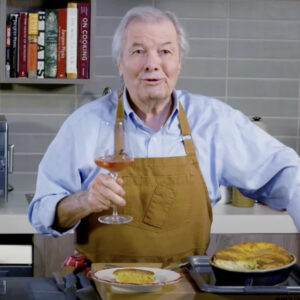 A Cooking Demonstration Catastrophe [*]
A Cooking Demonstration Catastrophe [*]
“Did you ever have any mishaps or cuts while you were filming one of your shows?
Cooking is the art of recovery or adjustment or compensation. One time, I was doing a demonstration for 2,000 people in Sacramento on a big tour. It was the Go Natural tour, so there were dancers, there were singers, and there was one portion for cooking, which was me. I did a cheese soufflé. I appeared in about half of the show. They calculated about 40 minutes before the end of the show so that I could go back on stage and retrieve the soufflé from the oven at the end. It was a question of timing.
I came on stage and I looked at the stove. Everything was working. I looked at the oven. I did my soufflé, put it into the oven and left, and didn’t come back for 40 minutes. Unbeknownst to me, the oven went on self-cleaning, like 750 degrees or whatever it was. You’ve never seen a soufflé as black and as burned as mine. I had a standing ovation, practically.
Was the oven filled with smoke when you opened the door?
Yes. There was no recovery there.
*Quotation above is taken directly from the website cited and is the property of that source. It is meant to inform the reader and to give credit where it is due.
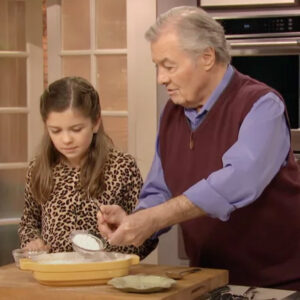 Why You Should Cook With Your Kids Early [*]
Why You Should Cook With Your Kids Early [*]
“Do you have any advice for people who want to cook with their kids?
You cannot have the kid eat pizza or some type of takeout food when they’re little while you cook a rack of lamb and then, at age 10 or 12, try to put the kid at the table and make them eat like you. You cannot do that. You’ve got to feed them the same food you eat when the kid is a year old, as soon as they start eating. When my daughter was a child, I don’t think we ever bought baby food. I cooked spaghetti or whatever I had (I cut down on the salt and all of that), and then I took some of it to put in the blender to make a puree out of it. The kid was used to those tastes from the beginning.
When the kid always works in the kitchen, that’s crucial. I held my daughter when she was a year and a half old and then made her stir the pot so she “made it,” so she was going to eat it, and likewise with my granddaughter. She came and sat next to me at the stove. She was [between three and six] years old. I said, “Okay, give me the salad. You think it’s clean? Okay, let’s go to the garden, let’s get some parsley.”
I said, “No, let’s try it, taste it, that’s parsley. Give me that tomato. You think that tomato is ripe? Smell it. You think it’s ripe?” The kid gets involved, touches the food, and that establishes a platform for communication, in a sense. After, the beauty of it is that you share the food at the table. It has to be done from the time the kid is born.”
*Quotation above is taken directly from the website cited and is the property of that source. It is meant to inform the reader and to give credit where it is due.
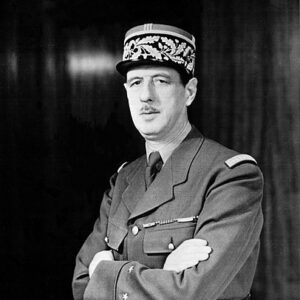 Stories from the French Presidential Kitchen [*]
Stories from the French Presidential Kitchen [*]
“You were [French President] Charles de Gaulle’s chef for a little bit in the ’50s. What were some of the de Gaulle’s family favorite things to eat?
When you cook for the presidents [like Charles DeGaulle]— I served [prime minister of India Jawaharlal Nehru, [Yugoslavian dictator Josip Tito, those were the heads of state at the time — you work with a protocol, usually, depending on whether the dinner is long, short, two meat, one meat, and so forth, [also] depending on the dietary requirements of the guests. You’re not going to serve a pork chop to the prime minister of Israel.
However, on the normal days, and certainly on Sundays, the de Gaulles were very devout Catholics who, after church, always had family dinner with children and grandchildren. I always made the menu with Madame de Gaulle and then did whatever they wanted. At that point, she wanted everything a certain way, she wanted a leg of lamb, but not too rare because it’s not good for the president, and some type of fish. You cook to please and to make people happy. It would be a different type of cooking, what we would do for state dinners and what we would do for them when they were by themselves.
There’s a story that you once rode in the presidential car to go buy bread.
I used to take care of the Secret Service and people like that who were always coming into the kitchen to get something to eat and drink, so they were nice to me if I needed to go somewhere. One day, I needed to get bread fast, and so they gave me a car with the siren and all that to go there [and] get bread. That was a fun memory.”
*Quotation above is taken directly from the website cited and is the property of that source. It is meant to inform the reader and to give credit where it is due.
